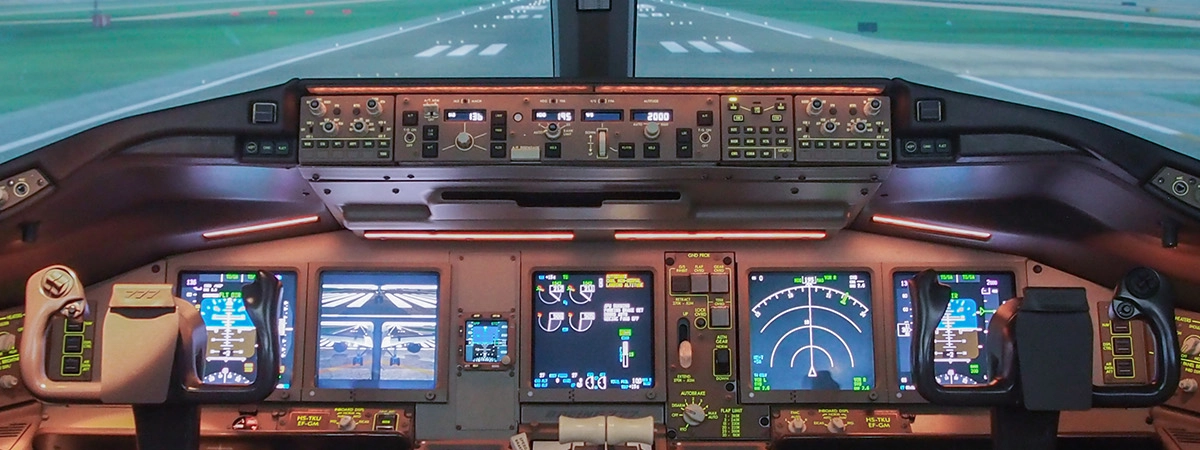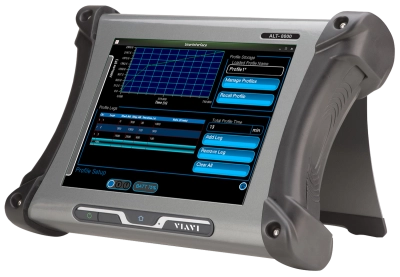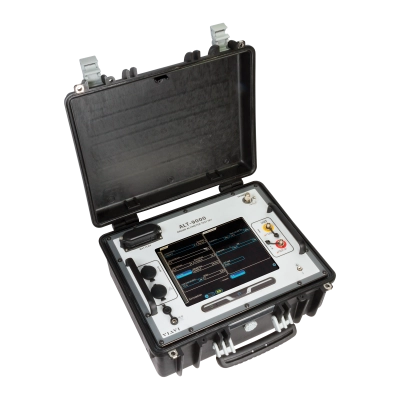Radio Altimeters (RADALT)
Test your installed FMCW and pulse radio altimeters quickly with portable test sets from VIAVI.
VIAVI radio altimeter equipment tests from the transmit/receive antennas to the indicator in the cockpit, allowing the operator to replicate in-flight conditions and isolate a bad component.
Radio altimeters provide critical real-time flight altitude data, enabling millions of safe flights to be completed each year. With today’s high reliance on automated control systems and complex navigation protocols, simply knowing whether the radio altimeter is operational before takeoff is not enough.
Portable altimeter test sets offered by VIAVI are the only complete test solutions that confirm radar altimeter performance from the antennas to the cockpit indicator, proactively diagnosing altimeter issues at the component level. Full linear altitude simulation provides confidence in antenna and radio performance over all expected flight conditions, without ever leaving the ground.
What is a Radio Altimeter?
A Radio Altimeter (RADALT) is an electronic instrument used to measure the distance between an aircraft and the terrain directly below it. The device analyzes the time and frequency signatures of reflected radio waves between 4.2 and 4.4 GHz and provides the resulting altitude data to several military and commercial aircraft systems.
Invented by Lloyd Espenschied nearly a century ago, the radio altimeter gained widespread acceptance during World War II and has since become an indispensable element of flight control. In addition to providing ongoing altitude data to the cockpit, the aircraft altimeter is used to facilitate instrument landings, ground proximity warning systems (GPWS), and the low-altitude, low-visibility flight operations that are a regular part of military aviation.
What is the difference between Radio Altimeter and Radar Altimeter technologies?
Often used interchangeably, the terms radio altimeter and radar altimeter are equally applicable to RADALT operation. Conventional radar (radio detection and ranging) methods utilize either pulsed or continuous radio waves reflected off a solid object to gather information on the object’s location, speed, and shape.
In much the same way, a radar altimeter transmits either pulsed or frequency modulated continuous wave (FMCW) radio signals from an aircraft in motion. These waves are reflected off the ground then recaptured by the altimeter’s receive antenna to generate information on elevation and terrain features.
Radio altimeters are now obligatory for commercial aviation, with most airliners equipped with redundant RADALT equipment. The FAA has also extended requirements to helicopters used for commercial or general aviation purposes. During flight, elevation data between takeoff and 2,500 feet above ground level (AGL) is monitored continuously by the radio altimeter.
VIAVI has developed the most comprehensive radar altimeter test equipment available for both military and commercial applications. Using a direct connection to the UUT or installed system via antenna couplers, fully dynamic altitude simulation allows technicians to confirm radar altimeter performance.
- Advanced flight technology familiar to casual passengers, including auto-landing in inclement weather and the flare maneuvers that help pilots to facilitate soft landings, are only made possible through the use of a radar altimeter.
- Military applications rely on situational awareness of the terrain, water, and other obstacles to detect immediate threats or tactical decision points. Highly accurate radar altimeters are used to navigate low altitude flight paths and trigger automatic pilot safety algorithms to prevent grounding.
- Next Generation radar altimeter technology is developing rapidly. This includes new strategies to reduce part count and improve reliability by combining the transmit (TX) and receive (RX) antennas into a single unit. Military applications are already deploying advanced low probability of intercept (LPI) altimeters with frequency hopping, low-power waveform features, including combined altitude radar altimeter (CARA) models.
- The all new VIAVI ALT-9000 utilizes fiber optic delay to allow it to work with all types of radio altimeters and support the testing of aircraft systems like TCAS and GPWS/TAWS with static or dynamic profiles in 5 foot increments up to 10,000 feet.
- Commercial applications are fully supported by the VIAVI ALT-8000 FMCW/Pulse Radio Altimeter Flight Line Test Set. Linear altitude simulation extends up to +5500 ft. for both pulse and frequency modulated continuous wave (FMCW) applications.
- The ALT-8000 is compatible with a wide variety of standard products, including many widely installed radios from Honeywell, Rockwell Collins, and low-altitude FreeFlight altimeters tailored to general aviation aircraft and helicopters.
- Military applications for radio altimeter systems continue to push the envelope for performance and accuracy. Military avionics utilize advanced radar altimeters with robust anti-jamming capabilities as they maneuver through sustained low altitude flight paths and rapid ascent/descent trajectories.
- The ALT-8015 FMCW/Military Pulse Radio Altimeter Test Set is an ideal solution for the demanding accuracy requirements of installed FMCW and pulse military altimeter applications. High-resolution, programmable flight simulation profiles at linear altitude rates of up to 120,000 feet/min. confirm radar altimeter performance.
- With an unmatched ability to test radar altimeter equipment of all vintages, models, and manufacturers, the VIAVI ALT-9000 altimeter tester has established a category all its own. The innovative fiber optic delay line and fast detector features support all legacy and next generation radar altimeter types, including LPI and CARA, to quickly trace radar altimeter errors to the antenna, coax, LRU, or indicator.
RADALT is a fundamental element of modern air travel, although additional altimeter types remain in use for aviation and other purposes. The radio altimeters supported by VIAVI test solutions include the two distinct subcategories of pulse and frequency modulated continuous wave (FMCW) altimeters.
- The pulse method directly interprets roundtrip time of a reflected radio pulse as a function of distance. The travel time of the waves is used to calculate altitude, based on the speed of light.
- An FMCW radar altimeter interprets the difference between send and receive frequencies to determine altitude. FMCW has become an increasingly popular radar altimeter option for commercial and military aviation as the digital signal processing improves.
- Low probability of intercept (LPI) altimeters developed for military applications have taken FMCW signal processing to the next level, with modulation variability and low-power signal waveforms used to ensure covertness. A combined altitude radar altimeter (CARA) is a special type of LPI altimeter that accommodates altitudes ranging from 0 ft. to 50,000 ft.
- CARA Altimeters with anti-jamming capabilities and automatic transmitter power adjustment for LPI operation are used extensively by the U.S. Air Force and Navy. These advanced radar altimeters are compatible with both high and low altitude flight operation. The forward-looking design is intended to meet both present and future performance requirements.
- The barometric altimeter predated the radio altimeter as an essential flight control and safety device and remains in use today for determining altitude both above and below 2,500 feet. The primary difference between radio altimeter and barometric altimeter technology is that the latter is based on air pressure rather than direct altitude measurement.
- Atmospheric pressure drops proportional to altitude increase, so the difference between the observed pressure and the known pressure at the airfield elevation can be used to determine altitude. Weather conditions that influence air pressure must also be factored in during barometric altimeter operation.
- Alternate altimeter technologies are evolving outside of the regulated aviation arena. This includes GPS or Global Navigation Satellite System (GNSS) altimeters as well as laser altimeters that utilize reflected infrared light waves rather than radio waves.
The basic operating principle behind a pulse or FMCW radar altimeter is based on the constant speed of light (300,000 km/sec), which enables accurate altitude calculations to be performed based on the roundtrip time of the pulse, or the frequency shift of the radio waves. Most radio altimeters operate within a narrow band of their overall 4.2 – 4.4 GHz range and remain accurate to within ± 2 feet at low altitude.
- A radio altimeter system includes a receiver transmitter as well as discrete transmit (TX) and receive (RX) RADALT antennas. A signal is sent from the transmitter to the transmit antenna, reflected off the ground, and then returns to the receive antenna.
- A pulse altimeter determines the altitude based on a simple calculation of pulse round trip time multiplied by one half the speed of light. The ultra-high speed of the transmitted signal allows an aircraft moving at Mach 1 or greater to send and receive signals from the same relative position on the aircraft without introducing significant radio altimeter errors.
- An FMCW radar altimeter relies on a consistent radio frequency transmission to interpret the proportional shift of the returning signal. Each 40 Hz increment between the transmitted signal frequency and that observed by the receiving antenna is equivalent to one additional foot of altitude.
- Radar altimeter errors that impact navigation and safety can be caused by even a minute variation in frequency. This highlights the need for portable, precise, and user-friendly altimeter test equipment with the ability to simulate all expected airborne conditions.
Despite the inherent criticality, testing of a radio altimeter in aircraft is not formally mandated. This leaves many pilots and operators with only “Go/No-Go” operational status to confirm radar altimeter performance. Even with the robust construction and quality standards observed by manufacturers, radar altimeter anomalies can lead to potentially catastrophic consequences. Radio altimeter system testing is a proactive, cost-effective approach to identifying faulty antenna, cable, or radio components and avoiding unnecessary LRU swaps.
- An undetected malfunction can induce an incorrect approach angle, unsafe obstacle clearance height, or early flare activation, among other potential hazards. Radio altimeter accuracy can also be challenged by unpredictable inputs, including variable ground conditions and thermal noise.
- Interference sources create radar altimeter safety and performance issues. New 5G deployments operating in nearby C-band (3.7 – 3.98 GHz) frequencies have led to FAA concerns over 5G transmissions interfering with RADALT at low altitudes.
- As an industry leader in both the aircraft altimeter testing and 5G network testing realms, VIAVI has devised robust test methods to identify potential interference issues between 5G transmissions and radar altimeters. Emulated 5G C-band communication allows the impact of interference-induced errors to be evaluated using a versatile VIAVI altimeter tester.
The world’s only RF-based portable radio altimeter test set portfolio also provides unmatched precision and usability. With direct-connect options supplemented by convenient radio altimeter system testing over supplied antenna couplers, flight safety is assured on the ground.
- The ALT-8000 radio altimeter test set features an easily programmable touchscreen interface and intuitive simulation profile creation, storage, and recall. Pulse and FMCW linear altitude simulation is accurate to ±1.5 ft. RADALT and RF type can be detected automatically prior to testing, saving valuable configuration time. A split-screen test view makes it easy to monitor and compare UUT and simulator values in real-time.
- The ALT-8015 is a rugged and versatile altimeter test set designed for demanding military applications. Customized flight profiles are accommodated by flexible altitude and duration options for each leg of the simulation profile. Rapid ascent and descent rates can be simulated precisely, with a linear altitude range extending to 8,000 ft. AGL for both pulse and FMCW military radio altimeter types.
- The ALT-9000 is a next generation radar altimeter test solution designed for a new era of secure aviation. The addition of fiber optic delay to traditional RF testing capabilities allows the ALT-9000 to accurately test all available RADALT types, including LPI and CARA variants with complex waveforms and signal processing algorithms. Complete profiles for dynamic altitude simulations and closed loop system testing enables accurate performance verification and troubleshooting.
每一阶段的支持
我们提供您所需的支持、服务、全面培训以及资源。这只是我们为最大程度提升您投资的价值所作努力的一部分。
咨询专家
请与我们联系以了解详细信息或获取报价。不管您有任何疑问,都可以咨询我们的专家来获得正确解答。


